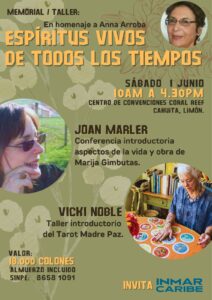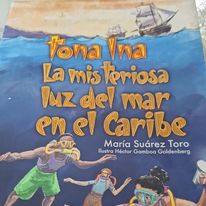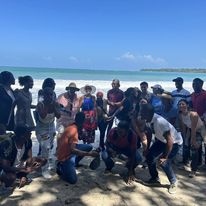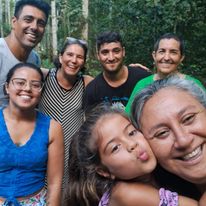María Suárez Toro,
May 15, 2024

- From May 28 to June 8, a delegation of women from the International Institute of Archaeomythology will visit Costa Rica to develop a Residency at Casa Marina of the Institute of Citizen Science of the Sea (INMAR CARIBE).
- They will be learning about the history, experiences, and living ancestral cultures expressed in Costa Rica’s Southern Caribbean coasts, highlands, and in museums in San José.
- They will be bringing their own experience to share with the local Bribri, Cabecar, Ngabe, Afro descendant, and mestizo population in Costa Rica and with other international institutions like UNESCO, National Geographic, and Costa Rican government delegates from the Ministry of Culture, the governmental Women’s Institute, and the National Museum of Costa Rica.
The group from the United States is composed of the Director of the Institute of Archaeomythology, Joan Marler; the author of the Mother Peace Tarot, Vicki Noble; and the artist Sorrel Mocchia de Coggiola.
An immersion program in Costa Rica’s Southern Caribbean includes visits to cultural sites and museums that explore the local expressions of ancestral knowledge of the multiethnic communities in Talamanca in the Caribbean.
The delegation will walk the paths of the culture constructed and contained in Costa Rica’s Southern Caribbean, highlighting the untold history of the slave ships being researched by Ambassadors of the Sea and the community of Cahuita.
They will also learn firsthand that in the Southern Caribbean, local people are engaged in communities where protected areas not only safeguard nature but also preserve underwater cultural heritage.
They will stay in Casa Marina, where breakfast and self-made dinner will be provided. Lunch will take place in cafeterias or restaurants at the locations of the day’s activities.
Visits to Archaeological Trails in Land and Sea
Cahuita National Park trail: An ocean trail by boat around Cahuita Point, which hosts remains of ancient artifacts possibly from slave ships, under archaeological study by local guides.
Cahuita Town Tour: A walk to the Parquecito in town with its founding history and culture, all the way into the history of the first known town established since 1823 by African descendant fishing families who came from nearby Caribbean islands and coasts to develop themselves in Cahuita Point.
It includes the story of the “The Cristina” shipwreck, a foundational event off the Bluff in Cahuita when former President González Flores capsized and was rescued by fishermen in 1915. In gratitude, he gave them land and titles.
A walk to the fisherfolk’s dock: learning how boats are made in Jamaican African style, how the fishermen fish, how they relate to the sea in a Protected Area, and their oral stories about the sunken ships in Cahuita.
Cahuita Tour guides and fisherfolk will guide them.
Visit the Calypso Cultural Center and its Archaeological Exhibit sponsored by UNESCO. Under the tutelage of the Cahuita Association of Development (ADIC), the tour will be guided by Ambassadors of the Sea.
Visit the Jade Museum and the National Museum in San Jose, especially to see the hundreds of clay female figurines that depict the expressions of indigenous peoples in Costa Rica regarding women´s place in pre-colonial societies. Guanacaste´s Guadalupe Urbina will guide them.
Seminar, Conference and Workshop:
 On June 1st in Cahuita, Joan Marler will deliver a Conference about the contributions of Dr. Marija Gimbutas, and Vicki Noble will lead a workshop on the Tarot Mother Peace.
On June 1st in Cahuita, Joan Marler will deliver a Conference about the contributions of Dr. Marija Gimbutas, and Vicki Noble will lead a workshop on the Tarot Mother Peace.

June 3-6, 2024. The delegation will take part in a Seminar to be held in Cahuita.
It is possibly the first time that a group of women from the United States with ancestral European origins comes to dialogue, having “done their own homework” about their own ancestry to share with ours. As researchers, students, and artists, they have studied the “Old Europe” ancestry, conceptualized as such by the emblematic European archaeologist Dr. Marija Gimbutas (1922-1994). They do not come to “study” us, “educate” us, or “re-colonize” our minds or theirs with current Westernism; instead, they come to deepen the ancestral roots that connect us beyond colonization, having studied and integrated their own ancestry into their lives.
Artist Sorrel Mocchia de Coggiola will be drawing portraits of participants and will present them in the Cultural Night on June 5 in Cahuita.
Other Artistic Residencies developed
in Casa Marina by INMAR Caribe
The 1st Artistic Residency was developed in the Casa Marina of the INMAR Caribe even before its inauguration. On July 17, Frank Murillo, along with Ivi Rodríguez from Profana Latinoamericana, stayed in the residence house to develop an artistic pre-production spectacular. The pre-performance “Ellas Son el Mar” and the Frank Murillo Recital at the Casa de la Cultura in Puerto Viejo.
The presentations attracted an enthusiastic audience of more than 30 people, including residents, tourists, and other artists, who enjoyed the presentations.
A raffle of the book Tona Ina: The Light in the Caribbean Sea and two scholarships for DNA testing with African Ancestry.com also enlivened the activity.

The DNA project is an initiative of CCBEM and INMAR Caribe that addresses the desire of the Afro-descendant population, particularly its diving youth, to know where their ancestors came from, now that the shipwrecks in the Cahuita National Park have been successfully identified. Thus, a process has been designed with an African DNA laboratory network that supports the DNA mapping project for residents.
The 2nd Artistic Residency was developed by two Argentine artists visiting from Panama who were “trapped with no way out” in the southern Costa Rican Caribbean due to the national strike in Panama in December against a mining project in that country.
Having learned about the “Ellas Son El Mar” project, More and María fell in love with the proposal, and moved to live in Casa Marina for a week, where they developed a proposal to monitor the attention to the “Goddesses of the Waters” on the floats. In 2022 and 2023, during the Parades of the International Day of Afrodescendants in Costa Rica, they also volunteered, helping to organize the Casa Marina.
The 3rd Artistic Residency took place when Tania Álvarez from Fundación Keme came to the Caribbean to participate in the “Bless Our Waters” Festival in December 2024. ATEC organized the Festival along with other initiatives.
Upon learning about the INMAR Caribe project during a workshop at the event, Tania requested an artistic posada. In collaboration with Ambassadors of the Sea and INMAR Caribe, a joint project was presented to the Directorate of Culture for execution in 2024.
The 4th Artistic Residency took place in Casa Marina at the end of December with three students from the archeology course of the Rural Tourism degree at the Caribbean Campus of the University of Costa Rica.

The three women from Limón proposed a collaborative residency, which allowed them to meet Ambassadors of the Sea and reorganize the scuba diving equipment warehouse of said initiative in the Caribbean.
The three students lived in Casa Marina. They came to help organize the diving equipment in the bodega and learned about the CCBEM and the INMAR Caribe.
The 5th Residency was a one-day Observatory-type visit that took place in December 2024 when 30 students and two professors from Earth University in the Province of Limón visited the Cahuita National Park.
 Guided by the Community Diving Center, they learned the history of the archaeological sites of two shipwrecks in the seas of Cahuita.
Guided by the Community Diving Center, they learned the history of the archaeological sites of two shipwrecks in the seas of Cahuita.
The vast majority of students came from Africa, Central America, and the Caribbean, learning about the history of the Transatlantic Slave Trafficking in its expression in Costa Rica and the search for the identity of the shipwrecks.
The 6th Artistic Residency featured a Capoeira team from Brazil and Chile visiting the Caribbean.

They helped to paint the “SEA” in the basement of Casa Marina, which is taking shape for the eventual artistic, cultural, and research residencies in citizen sciences of the Sea – INMAR CARIBE.
The 8th Research Residency took place in May, from the 4th to the 6th, 2024, when high school students in Heredia came to Cahuita to conduct a series of interviews in Sixaola for their course.
This is how Maya Aravena, coordinator of the Residence, tells it: “Our research group is made up of students Maya Aravena, Sofía Arce, Jimmy Ayala, and Valeria Zumbado from Colegio Humanistico, Cede Omar Dengo. Our research project is called “Women made vulnerable by flooding in rural areas: a focus on the community of Sixaola.”
She added that “the stay at the INMAR house helped us be closer to the research to obtain an analysis of the current state through interviews with indigenous women and community leaders in Sixaola.”
Here is their evaluation in a video produced by them about their stay at Casa Marina:

